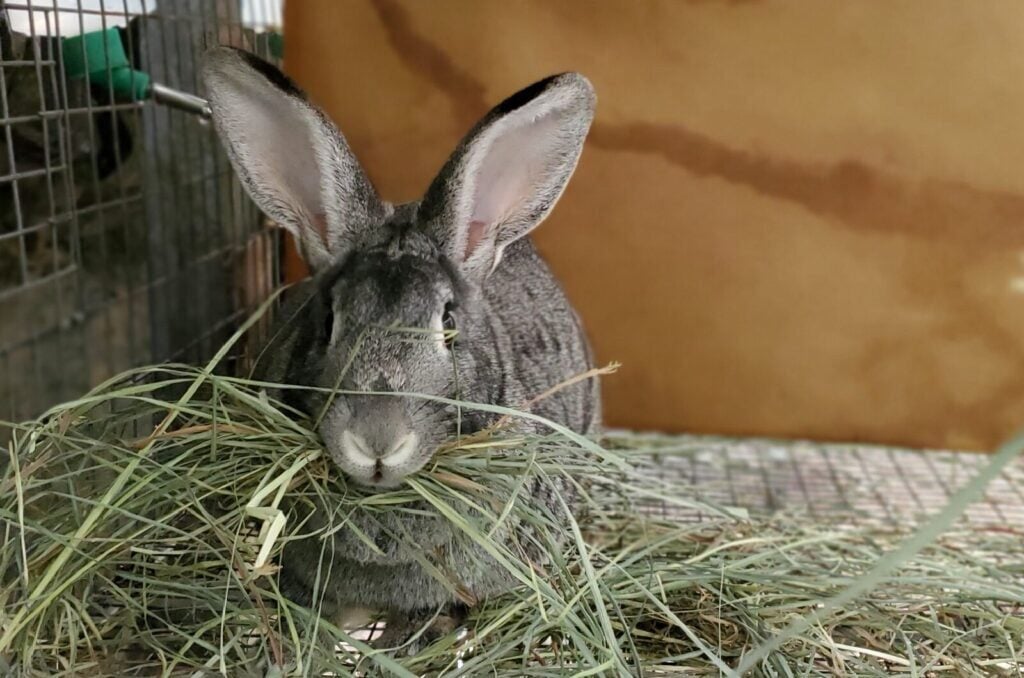No products in the cart.
NEWS
13 Tips to Raising Rabbits for Meat
Backyard rabbit farming is on the rise, and quite sustainable for those seeking to own their food source. Here are 13 key tips to raising rabbits for meat whether you reside in town or out in the country.

The incorporation of meat rabbits onto the homestead was a rather easy decision for us. In fact, rabbits were incorporated one year after the addition of laying hens, and prior to us raising broiler birds for meat.
I am going to be very honest about this, I made the decision to bring rabbits onto the property without much research. Luckily the woman who we purchased our small herd from allowed us to purchase stackable cages and gave us an excellent, but quick, rundown of what we needed to do.
So, we winged it, though not blindly. I had homesteading friends who were already raising rabbits for meat and they were able to answer any question I had rather quickly and effortlessly. These individuals have been raising rabbits for years, and for that I am thankful.
With that said, you’re here because you are researching before you jump in. Allow me to share my 13 reasons as to why you should raise backyard meat rabbits. I can promise you, it will be one of the best sustainable living decisions you can make.
Raising Rabbits for Meat
There are two types of people – people who understand the purpose of raising meat rabbits and others who do not. Now, this is not because they won’t eat rabbit, it is because they are not comfortable with the butchering process.
Let me be honest with you, processing day is still quite difficult for me and we have been raising rabbits for many years. How do I manage butchering an animal many see as pets?
Individuals seek to own a clean food source, which requires them to be able to raise and butcher their own meat. I know the importance of consuming a clean food source, and I’ll do whatever I need to in order to ensure my family is eating healthy, clean foods.
Is raising rabbits for meat easy? Yes, the process of establishing the rabbitry, daily chores, and breeding is. If you need more convincing here are 13 reasons as to why you should raise rabbits for meat on the homestead.

Raising Backyard Meat Rabbits
There are 14 incredible meat rabbit breeds to choose from. Each breed brings to the table different qualities whether it is the amount of meat provided, a breed which produces a large litter of kits, or the opportunity to work the pelt.
Before incorporating rabbits onto the property make sure to choose the best rabbit breed for your end goal.
1. Ideal for Property of all Sizes
Contrary to what many believe, raising rabbits is extremely convenient and can be achieved regardless of where you reside. There are many options as to the type of structure needed to place the rabbit cages.
- Garden shed
- Barns
- 3 sided lean-to
- and even in the garage
Below you will find the 3 options for caging rabbits.
2. Minimal Startup Cost
The start up cost for keeping rabbits is quite minimal consisting of a few basic items –
- Herd – 1 buck to 2 does. The price will vary depending on the breed and if the animals are show quality
- Water bottles
- Pellet feeders
- Hay holders
- Rest pads – used to prevent sore hocks
- Nesting boxes
- Chew toys – Make chew toys which are safe for the herd for good teeth management

3. Housing
There are three methods for housing rabbits and which one you choose will depend on the structure in which the herd will be kept. Be sure to add a resting spot (a soft spot for their feet to rest) if you use wire cages.
- Stackable cages – this type of housing is ideal garden sheds and garages
- Hanging cages – perfect for a lean-to, barn, or garage
- Colony setting – garden shed or barn
4. Raise Heritage Breeds
There are 14 rabbit breeds consisting of standard and heritage breeds which are excellent to raise for meat purposes.
Standard breeds are more commonly found whereas heritage breeds are prized and slightly difficult to come by.
Heritage breeds are watched by the Livestock Conservancy and have been making a comeback due to the awareness the organization provides. Keep in mind, heritage breeds and larger breed rabbits have slower growth rates so they take longer to reach butchering age.
Our homestead raises two heritage rabbit breeds, the Harlequin and the American Chinchilla.

5. Healthy Meat Option
Rabbit meat is lean white meat similar to chicken meat. Unlike wild rabbits, domesticated rabbits have a mild gamey flavor, though rabbits raised on pasture tend to have a gamier flavor.
Unlike chicken or beef, rabbit is high in B12, which is excellent for those who are deficient.
6. Sustainable Food Source
A doe, depending on the breed, which is bred twice a year can produce up to 168 pounds of meat a year. This figure is based on a doe birthing an average of 5 kits per litter. That is a total of 336 pounds of meat a year from 2 does.

7. Quick to Reach Harvest Date
Rabbits can be harvested as early as 8 weeks of age, though many prefer to harvest them around 4 to 5 pounds. I prefer to harvest between 8 to 12 weeks, but no later than 12 weeks of age as the meat begins getting tough.
- 8 weeks old – fryer
- 12 week old – roaster
- over 12 weeks – stewer
I prefer to dispatch between 8 to 9 weeks as the rabbit is more tender and can be used as a fryer. Anything after 8 weeks the meat is less tender, not to mention, you are losing money by continually feeding it as they will begin to consume more feed after this age.

8. Minimum Care
Good animal husbandry will require you to groom your herd as they need it, roughly two to three times a year for most breeds. Keep in mind, grooming a herd refers to your breeding pair and not your meat stock.
- Nails will need to be trimmed as needed with a cat nail trimmer
- Rabbits with longer fur may need to be brushed to help with molting (shedding of the fur)
- Chew toys must be provided to help keep the front teeth filed
9. Minimal Feed Cost
Our rabbits receive free choice hay and quality rabbit complete pellet feed at their evening feeding. In addition to this they receive fresh vegetables and/or grass daily to help reduce the cost of hay and pellet feed.
Feeding rabbits naturally should never replace hay or pellet feed but act as a filler.

10. Free Manure
There is no better instant fertilizer than rabbit manure as it is not considered to be hot and will not burn crops or flowers. In addition to utilizing rabbit poop, rabbit urine also makes a great fertilizer. Both the poop and urine are high in –
- Nitrogen
- Phosphorus
- Potassium
Collect the manure and urine and evenly distribute throughout the garden beds.
11. Easy to Process
There are no expensive tools required for processing rabbits. The more common methods for dispatching rabbits has been the broomstick method or with the use of a pellet gun. I have recently had the opportunity to use the Hopper Popper and found that it was an efficient and humane method for dispatching rabbits. This tool is also a lot easier on the back than the broomstick method.
12. Showing for 4H
Rabbits are a great animal for children who are in 4H. Many of the smaller meat rabbit breeds are small enough for those new to 4H to handle easily. Children have an incredible opportunity to make an income with a backyard rabbit farming business. Teaching kids how to raise backyard meat rabbits creates good stewards to the homesteading and farming movement.

13. Backyard Rabbit Farming
Many counties in the United States do not consider rabbits to be classified as livestock, which means they are not closely regulated.
For this reason many families have created a backyard rabbit farming business, earning a fair amount of money yearly to compensate for the cost of raising rabbits.
- In many states rabbit meat can be sold as “pet food” for roughly $9 a pound.
- A pelt which has been tanned can easily be sold starting at $20 a hide depending on how well it is prepared.
- Manure can be sold by the bucket full, set your price and people will be lined up to purchase it. I sell 5-gallon buckets for $10.
- Kits can be sold for meat production or with a pedigree for showing. Many 4H clubs do not require a pedigree to show, however, it is best to check the club’s rules prior to registering a rabbit.
As you can see the benefits of raising backyard meat rabbits is great and the opportunity to create a backyard rabbit farm for extra income is even greater.
The only advice I will give is this, do not get carried away with breed and make sure you have a solid plan to butcher or sell the kits once they have been weaned.
Enjoy your new sustainable adventure, it is going to be a great one!

Sharing is caring!



